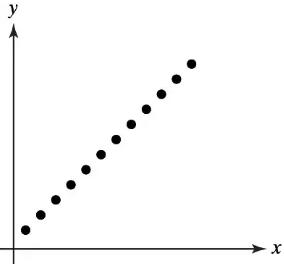Graphical Analysis In Exercises 11–14, determine whether there is a perfect positive linear correlation, a strong positive linear correlation, a perfect negative linear correlation, a strong negative linear correlation, or no linear correlation between the variables.
Table of contents
- 1. Intro to Stats and Collecting Data1h 14m
- 2. Describing Data with Tables and Graphs1h 55m
- 3. Describing Data Numerically2h 5m
- 4. Probability2h 16m
- 5. Binomial Distribution & Discrete Random Variables3h 6m
- 6. Normal Distribution and Continuous Random Variables2h 11m
- 7. Sampling Distributions & Confidence Intervals: Mean3h 23m
- Sampling Distribution of the Sample Mean and Central Limit Theorem19m
- Distribution of Sample Mean - Excel23m
- Introduction to Confidence Intervals15m
- Confidence Intervals for Population Mean1h 18m
- Determining the Minimum Sample Size Required12m
- Finding Probabilities and T Critical Values - Excel28m
- Confidence Intervals for Population Means - Excel25m
- 8. Sampling Distributions & Confidence Intervals: Proportion1h 25m
- 9. Hypothesis Testing for One Sample3h 57m
- 10. Hypothesis Testing for Two Samples4h 50m
- Two Proportions1h 13m
- Two Proportions Hypothesis Test - Excel28m
- Two Means - Unknown, Unequal Variance1h 3m
- Two Means - Unknown Variances Hypothesis Test - Excel12m
- Two Means - Unknown, Equal Variance15m
- Two Means - Unknown, Equal Variances Hypothesis Test - Excel9m
- Two Means - Known Variance12m
- Two Means - Sigma Known Hypothesis Test - Excel21m
- Two Means - Matched Pairs (Dependent Samples)42m
- Matched Pairs Hypothesis Test - Excel12m
- 11. Correlation1h 24m
- 12. Regression1h 50m
- 13. Chi-Square Tests & Goodness of Fit2h 21m
- 14. ANOVA1h 57m
11. Correlation
Scatterplots & Intro to Correlation
Problem 9.1.14
Textbook Question
Graphical Analysis In Exercises 11–14, determine whether there is a perfect positive linear correlation, a strong positive linear correlation, a perfect negative linear correlation, a strong negative linear correlation, or no linear correlation between the variables.

 Verified step by step guidance
Verified step by step guidance1
Step 1: Observe the scatterplot provided in the image. The points are closely aligned along a straight line that slopes upward from left to right.
Step 2: Recall the definition of correlation. A perfect positive linear correlation occurs when all data points lie exactly on a straight line with a positive slope, indicating a direct proportional relationship between the variables.
Step 3: Compare the alignment of the points in the scatterplot to the characteristics of a perfect positive linear correlation. Since the points are perfectly aligned along the upward-sloping line, this matches the definition of a perfect positive linear correlation.
Step 4: Note that there is no deviation of the points from the line, which confirms the relationship is perfect and positive.
Step 5: Conclude that the scatterplot demonstrates a perfect positive linear correlation between the variables.
 Verified video answer for a similar problem:
Verified video answer for a similar problem:This video solution was recommended by our tutors as helpful for the problem above
Video duration:
2mPlay a video:
Was this helpful?
Key Concepts
Here are the essential concepts you must grasp in order to answer the question correctly.
Correlation
Correlation measures the strength and direction of a linear relationship between two variables. It is quantified by the correlation coefficient, which ranges from -1 to 1. A value of 1 indicates a perfect positive correlation, meaning as one variable increases, the other also increases proportionally. Conversely, a value of -1 indicates a perfect negative correlation, where one variable increases as the other decreases.
Recommended video:
Guided course

Correlation Coefficient
Linear Relationship
A linear relationship between two variables means that the relationship can be represented by a straight line on a graph. This implies that changes in one variable result in proportional changes in the other. In the context of correlation, a strong linear relationship suggests that the data points closely follow a straight line, indicating predictability in the relationship between the variables.
Recommended video:
Guided course

Intro to Least Squares Regression
Scatterplot
A scatterplot is a graphical representation of two variables, where each point represents an observation. It helps visualize the relationship between the variables, making it easier to identify patterns, trends, or correlations. In the provided image, the points are closely aligned along an upward sloping line, indicating a perfect positive linear correlation, where increases in one variable correspond to increases in the other.
Recommended video:
Guided course

Scatterplots & Intro to Correlation

 6:36m
6:36mWatch next
Master Scatterplots & Intro to Correlation with a bite sized video explanation from Patrick
Start learningRelated Videos
Related Practice
Textbook Question
28
views
